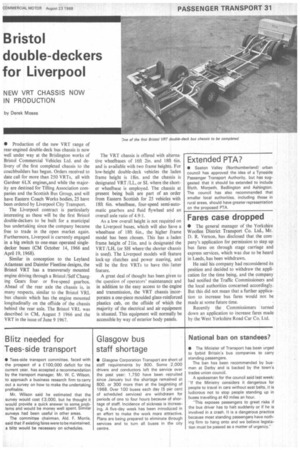B ristol
Page 33

If you've noticed an error in this article please click here to report it so we can fix it.
double-deckers for Liverpool
NEW VRT CHASSIS NOW IN PRODUCTION
by Derek Moses • Production of the new VRT range of rear-engined double-deck bus chassis is now well under way at the Brislington works of Bristol Commercial Vehicles Ltd. and delivery of the first completed chassis to the coachhuilders has begun. Orders received to date call for more than 250 VRTs, all with Gardner 6LX engines,and while the majority are destined for Tilling Association companies and the Scottish Bus Group, and will have Eastern Coach Works bodies, 25 have been ordered by Liverpool City Transport.
The Liverpool contract is particularly interesting as these will be the first Bristol double-deckers to be built for a municipal bus undertaking since the company became free to trade in the open market again. Furthermore, Liverpool is currently engaged in a big switch to one-man operated singledecker buses (CM October 14, 1966 and April 19, 1968).
Similar in conception to the Leyland Atlantean and Daimler Fleetline designs, the Bristol VRT has a transversely mounted engine driving through a Bristol /Self Changing Gears fouror five-speed gearbox. Ahead of the rear axle the chassis is, in many respects, similar to the Bristol VRL bus chassis which has the engine mounted longitudinally on the offside of the chassis behind the rear axle. The Bristol VAL was described in CM, August 5 1966 and the VRT in the issue of June 9 1967. The VRT chassis is offered with alternative wheelbases of 16ft 2in. and 18ft 6in. and is available with two frame heights. For low-height double-deck vehicles the laden frame height is 18in. and the chassis is designated VRT ILL, or SL where the shorter wheelbase is employed. The chassis at present being built are part of an order from Eastern Scottish for 25 vehicles with 18ft 6in. wheelbase, four-speed semi-automatic gearbox and fluid flywheel and an overall axle ratio of 4.9:1.
As a low overall height is not required on the Liverpool buses, which will also have a wheelbase of 18ft 6in., the higher frame model has been chosen. This has a laden frame height of 21in. and is designated the VRT /LH, (or SH wherethe shorter chassis is used). The Liverpool models will feature lock-up clutches and power steering, and will be the first VRTs to have this latter feature.
A great deal of thought has been given to the question of operators' maintenance and in addition to the easy access to the engine and transmission, the VRT chassis incorporates a one-piece moulded glass-reinforced plastics cab, on the offside of which the majority of the electrical and air equipment is situated. This equipment will normally be accessible by way of exterior body panels.




















































































































